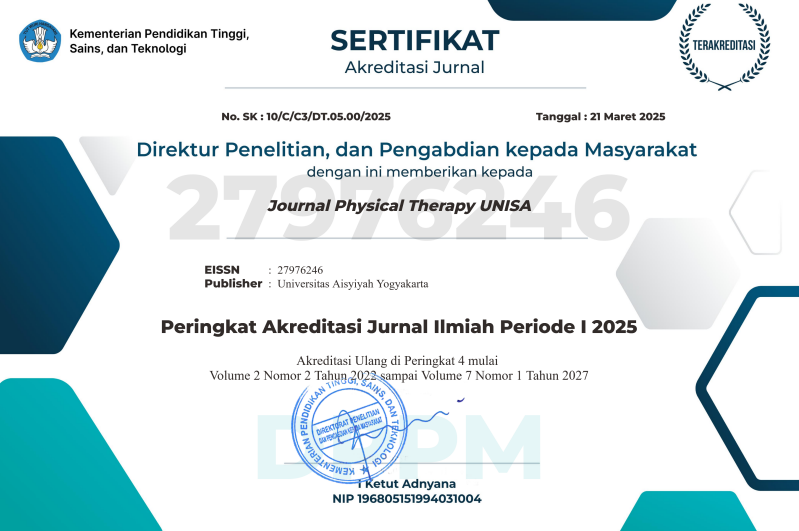Fisioterapi pada pasien dengan Tetraparesis Ensefalitis: laporan kasus
DOI:
https://doi.org/10.31101/jitu.2416Abstract views 2762 times
Keywords:
tetraparesisensefalitis, peran fisioterapi, fungsionalAbstract
Downloads
References
Dalmau J, Lancaster E, Hernandez EM, Rosenfeld MR, Gordon RB. Clinical experience and laboratory investigations in patients with anti- NMDAR encephalitis. Lancet Neurol. 2011;10(1):63–74.
Ferdinand P. Mitchell L. Anti NMDA receptor encepahlitis. J Clin Cell Immunol. 2012;S10:007.
Gu Y, Zhong M, He L, Li w, Huang Y Liu J, dkk. epidemologi of antibody-positive autoimmune encephalitis in southwest china: a multicenter study. Frontiers in Imunology 10:2611 [Online Jurnal] November 2019 [diunduh 10 Januari 2020]
Gable MS, Gavali S, Radner A, Tilley DH, Lee B, Dyner L, dkk. Anti-NMDA receptor encephalitis: report of ten cases and comparison with viral encephalitis. Eur J Clin Microbiol Infect Dis. 2009; 28:1421–9.Directorate of National Vector Borne Diseases Control Programme, Ministry of Health & Family Welfare India. 2012. Guidelines for Clinical Management of Japanese Encephalitis : http://nvbdcp.gov.in/Doc/Clinical%20Manegement-JE.pdf
Harsanti, S. (2013). Efektifitas Terapi Masase dan Terapi Latihan Pembebanan dalam Meningkatkan Range Of Movement Pasca Cedera Ankle Ringan pada Pemain Bola Basket Putri Di Unit Kegiatan Mahasiswa Universitas Negeri Yogyakarta. Fisioterapi, 11.
Hillengass,E. Z. (2014). Intisari Fisioterapi : Buku Praktik Klinik. Philadelphia, Pennysylvania: EGC.
Hsu, S., Oda, H., Shirahata, S., & Watanabe, M. (2018). Effects of core strength training on core stability, 1014–1018.
Irfan, M. (2010). Fisioterapi Pada Insan Stroke. Graha Ilmu.
Kayser MR, Dalmau J. Anti NMDA receptor encephalitis in psychiatry. Curr Psychiatry Rev. 2011;7(3):189–93.
Karen Kenyon, Jonathan Kenyon. (2004). The Physiotherapist's Pocket Book . Philadelphia: Churchill Livingstone
Raine, S. (2007). Current theoretical assumptions of the Bobath Concept as determined by the member of BBTA. Physiotherapy theory and Practice, 23,137-152.
Raine, s., Meadows, L., & Lynch, M. (2009). Bobath Concept Theory and Clinical Practice in Neurological Rehabilitation. Chicester: Black Well.
Ryerson S, Neurological Assessment: The Basis of Clinical Decision Making. In: Lennon S, Stokes M, editors. Pocketbook of Neurological Physiotherapy. Elsevier Health Sciences; 2008 Oct 10.
Tunkel A.R, Glaser C.A, Bloch KC, Sejvar JJ, Marra CM, Roos KL, dkk. The management of encephalitis: clinical practice guidelines by the infectious diseases society of America. Clin Infect Dis. 2008;47:303–27.
Venkatesan, A. (2014). Diagnosis and management of acute encephalitis, 206–215.
Walker, T. (2017). Encephalitis. Healthline.
Downloads
Published
How to Cite
Issue
Section
License
Copyright (c) 2022 Dewi Suci Mahayati

This work is licensed under a Creative Commons Attribution-ShareAlike 4.0 International License.









